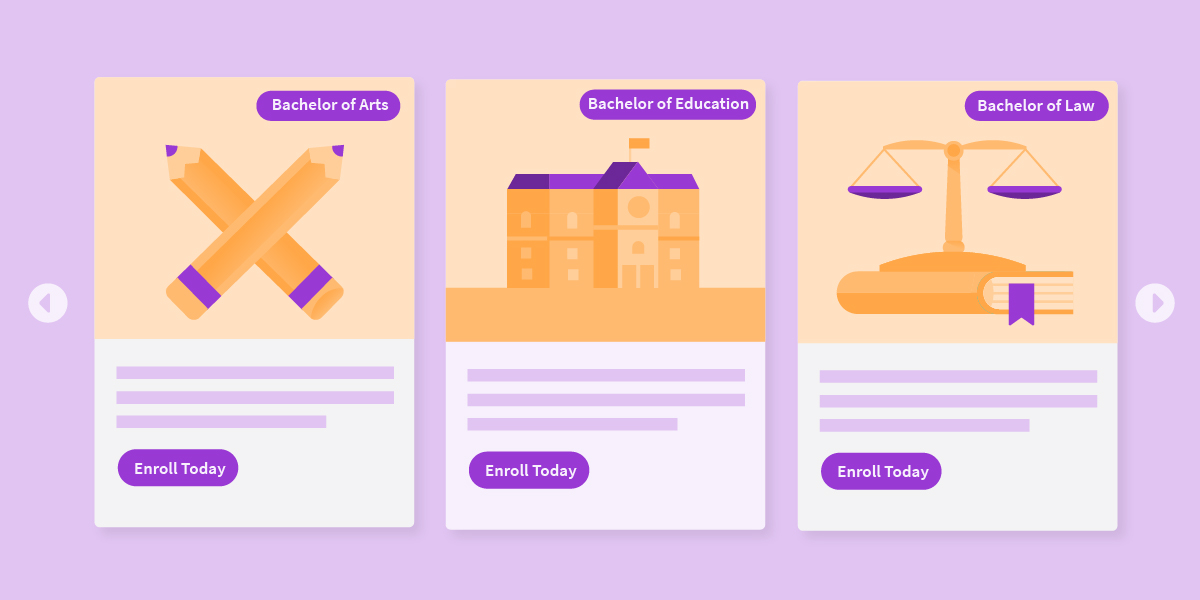Education marketing has been consistently evolving to adapt to the drastic shift to online learning. While in-classroom learning is bouncing back, the adoption of virtual learning environments has created new opportunities. Among them, digital marketing has taken center stage as a strategy for increasing enrollment and bringing prospective students into programs.
To find success in the upcoming school year and beyond, marketers should embrace recent changes to the education landscape. To help you earn that A, we’ve highlighted current education marketing trends, how education is evolving, and digital strategies you can leverage for your education marketing campaigns.
Trends That Are Impacting Education Marketing
During and after the pandemic, institutions have made quick changes to help them adjust to educating students in a remote-first world For many, this has meant shifting to online education. The adoption of digital in education has resulted in a couple of notable trends that education marketers should keep top of mind.
1. Education Is for Everyone
Education is being increasingly viewed as a lifelong activity rather than a time-bound activity with set milestones, like graduating college. Students today are not just prospective school or college applicants, they are often professionals who are looking to upskill, retrain for a different career, or refresh their skills.
This is especially relevant with the advent of Generative AI—in a study conducted by IBM, 46% of executives said they are spending more resources in upskilling and reskilling their workforce to work with AI.
2. Time Spent with Screens Is Rising
While many students returned to the classroom after the pandemic, the increase in screen time during that time is now an established habit that will likely persist. The average screen time of school-aged children, 6 to 14, is 2.77 hours per day, and 46% spend more than 2 hours per day with screens.
3. Back to School Shopping Goes Digital
Retail saw a shift to digital since 2020, as did educational shopping. With education becoming digital-first, electronic products became the focus of back to school shopping lists for students and teachers. Parents spent $9.5 billion USD in 2023 on tech products for their kids as part of their back to school purchases. Tech products include computers and hardware, electronic gadgets, digital subscriptions, and voice/data plans.
How Education Is Evolving
The above trends are a big part of the equation when it comes to how education is evolving. They are driving shifts in the education landscape that are important to note because these shifts highlight the audiences that education marketers should be targeting, and how best to reach those audiences. Here are 4 key ways in which education is evolving.
E-learning Is Here To Stay
The pandemic accelerated the shift towards remote and hybrid learning. These trends are unlikely to reverse due to a confluence of factors, from safety concerns to the convenience and accessibility of remote learning. There will be one billion users of e-learning products by 2027. With the 5G rollout ramping up, wide access to high speed internet is expected to turbocharge applications that rely on streaming, with education being one of the beneficiaries.
Fewer Students Are Interested in Full-service Degrees
Students are increasingly opting for ‘nano-learning’ models, such as micro-credentialing, competency-based education, and nano-degrees as alternatives.
According to the National Student Clearinghouse Research Center, students prefer shorter-term credentials. For instance, in 2023 enrollment in undergraduate certificate programs in the United States was up 9.9%, compared to 3.6% for associate degrees and 0.9% for bachelor’s degrees.
Affordability Is a Top Factor in Decision Making
Affordability, reputation, and academic credit for work or life experiences are the top three influencing factors for selecting a school. According to Statista, 77% of survey respondents chose affordability as the leading factor behind choosing an online program. Reputation of the school or program (63%), ability to customize program with electives (60%), and quickest path to a degree (58%) are some of the other factors that are high priority for students.
Earn an A With These Education Marketing Tips
Now that we’ve seen the full report card when it comes to trends and the education landscape, it’s time to dig into the best digital strategies for education marketers. Here are 4 tips that education marketers can leverage when building their digital strategy.
1. Be Attentive to Emerging Formats
Student habits are shifting, which means it’s more important than ever to pay attention to emerging formats. For example, one-fifth of TikTok users are women between 18 and 24 years of age.
Over-the-top (OTT), live video, and audio podcasts have all seen a surge in the last year and continue to capture an ever-growing percentage of the digital media diet. To capture the attention of prospective students, it’s important to have a pulse on where they are spending their time, and then be sure to be present on those channels.
2. Adjust Your Strategy According to Digital Adoption
In the past, the education sector has had a more traditional marketing approach to the back to school season. Now is the time to embrace the digital signals students and educators have been adjusting to in the last year. For education marketers planning and strategizing for the school year ahead, it’s important to consider their prospective student’s perspective and habits, so that you’re able to connect with them, and offer a personalized experience. The starting point for this is to ensure institutions are creating a strong brand presence online, and a coherent digital strategy. This will help them to stand out from the crowd while gathering data to make informed decisions.
3. Target Your Desired Audiences With Care
Key life decisions, such as a college selection, career change. and high-value purchases aren’t often made in isolation. Education marketers should leverage demographics and life-event data to not only capture prospective students, but also parents, family members, and peer groups.
You can narrow down your targeting by using tactics like contextual advertising to target professionals who are looking to upskill and keep pace with demands of this skills-based economy. Or incorporate geo radius targeting as a strategy to reach prospective students, since 44% of online students live within 25 miles or less of the college campus.
4. Use a Multi-channel Strategy to Capture Attention
Students today spend their time on a mixture of channels. They might scroll social platforms first thing in the morning, listen to a podcast on their commute, and then spend the afternoon browsing online. Education marketers should update their approach to reflect this consumer behaviour shift with a multi-channel strategy. With a multi-channel strategy, you can reach prospective students throughout the entire funnel, creating a cohesive story across channels like native, display, video, connected TV (CTV), audio, in-game, and digital out-of-home.
How Education Marketers Can School the Competition
In education marketing today, a one-size-fits-all approach won’t work. Education marketers should be on top of the rapidly changing trends and evolving education landscape, so that they’re able to speak to changing concerns and expectations of prospective students.
Affordability, for example, ranks highest among factors that influence online program choice. Given this, education marketers should craft messaging that addresses pricing and highlights return on investment. It’s also key to cater the messaging depending on the type of student being targeted. For example, when reaching audiences who are evaluating a career change, emphasizing earning growth potential makes the most sense.
Ready to excel in education marketing? Earn an A in education marketing by being willing to experiment, and keeping your strategy fresh and nimble.
Tune into this episode of the How Agencies Thrive podcast to learn how education marketers have adopted new strategies to stay relevant and competitive in a rapidly changing education climate.





